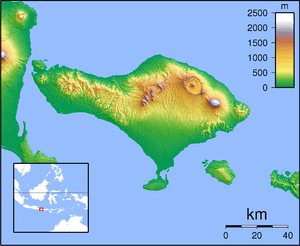Pura Besakih


Besakih
Pura Besakih is a temple complex in the village of Besakih on the slopes of Mount Agung in eastern Bali, Indonesia. It is the most important, the largest and holiest temple of Hindu religion in Bali,[1] and one of a series of Balinese temples. Perched nearly 1000 meters up the side of Gunung Agung, it is an extensive complex of 23 separate but related temples with the largest and most important being Pura Penataran Agung. The temple is built on six levels, terraced up the slope. The entrance is marked by a candi bentar (split gateway), and beyond it the Kori Agung is the gateway to the second courtyard.[2]
History
The precise origins of the temple are unclear but its importance as a holy site almost certainly dates from prehistoric times. The stone bases of Pura Penataran Agung and several other temples resemble megalithic stepped pyramids, which date back at least 2,000 years.
It was certainly used as a Hindu place of worship from 1284 when the first Javanese conquerors settled in Bali. By the 15th century, Besakih had become a state temple of the Gelgel dynasty.[2]
Location
It was built on the south slopes of Mount Agung, the principal volcano of Bali.
Architecture

Pura Besakih is a complex made up of twenty-three temples that sit on parallel ridges. It has stepped terraces and flights of stairs which ascend to a number of courtyards and brick gateways that in turn lead up to the main spire or Meru structure, which is called Pura Penataran Agung. All this is aligned along a single axis and designed to lead the spiritual person upward and closer to the mountain which is considered sacred.[3]
The main sanctuary of the complex is the Pura Penataran Agung. The symbolic center of the main sanctuary is the lotus throne or padmasana, which is therefore the ritual focus of the entire complex. It dates to around the seventeenth century.[4]
A series of eruptions of Mount Agung in 1963, which killed approximately 1,700 people[5][6] also threatened Pura Besakih. The lava flows missed the temple complex by mere meters. The saving of the temple is regarded by the Balinese people as miraculous, and a signal from the gods that they wished to demonstrate their power but not destroy the monument the Balinese faithful had erected.
Festivals
Each year there are at least seventy festivals held at the complex, since almost every shrine celebrates a yearly anniversary. This cycle is based on the 210-day Balinese Pawukon calendar year.[4]
It had been nominated as a World Heritage Site as early as 1995, but remains unvested.[7]
Visitors to this temple should exercise caution as there is a syndicate operating in and around the premise of this temple. They target tourists by offering a compulsory "tour guide" at exorbitant charges. They also perform "prayers" and request for tips at the end of the "tour". Visitors who decline their "services" are dealt with rather aggressively.,[8][9]
Visitors
In 2013, foreign visitors count is 84,368 persons (77.2 percent), while domestic visitors is 24,853 persons (22.8 percent).[10]
Problems
The illegal forced donations which is actually an extortion was done by local youths from surrounding villages to visiting tourists. Usually foreign tourist are asked for additional 50 US dollar while Indonesians are asked for 200,000 rupiah. This is illegal money collection, however the local authority seems to do nothing to stop this extortion.[11]
Gallery
 The main temple of Besakih
The main temple of Besakih- Pura Besakih
- Pura Besakih
 Pura Besakih
Pura Besakih A prayer ceremony at Besakih Temple
A prayer ceremony at Besakih Temple Bali view from Besakih/Mother temple's main gate
Bali view from Besakih/Mother temple's main gate
See also
Notes
- ↑ "Mount Agung and Pura Besakih". Sacred Destinations. Retrieved 20 July 2010.
- 1 2 Lonely Planet: Bali and Lombok, April 2009, p 215
- ↑ Mitchell, George (1998). The Hindu temple: an introduction to its meaning and forms. University of Chicago Press. p. 168. ISBN 0-226-53230-5.
- 1 2 Davison, Julian (2003). Introduction to Balinese architecture. Tuttle Publishing. p. 60. ISBN 0-7946-0071-9.
- ↑ "Geology of Mt.Agung". Pusat Vulkanologi & Mitigasi Bencana Geologi — VSI. Retrieved 26 April 2009. Archived 29 September 2008 at the Wayback Machine.
- ↑ Zen, M. T.; Hadikusumo, Djajadi (December 1964). "Preliminary report on the 1963 eruption of Mt.Agung in Bali (Indonesia)". The SAO/NASA Astrophysics Data System. Retrieved 26 April 2009.
- ↑ "Besakih — UNESCO World Heritage Centre". Tentative Lists. United Nations Educational, Scientific and Cultural Organization. 19 October 1995. Retrieved 27 April 2009.
- ↑ The Mother Temple of Besakih - Bali - Reviews of The Mother Temple of Besakih - TripAdvisor
- ↑ Lonely Planet Bali & Lombok - Ryan Ver Berkmoes - Google Books
- ↑ "Karangasem Perlu Ciptakan Objek Wisata Baru". June 15, 2014.
- ↑ "Ada Pungutan Liar di Besakih, Pariwisata Bali Tercoreng". CNN Indonesia.
Further reading
- I Nyoman Darma Putra and Michael Hitchcock (2005) Pura Besakih: A world heritage site contested in Indonesia and the Malay World, Volume 33, Issue 96 July 2005, pages 225 - 238
- Stuart-Fox, David J.(2002) Pura Besakih: temple, religion and society in Bali KITLV, Original from the University of Michigan (Digitized 5 September 2008 into Google Books) ISBN 90-6718-146-3, ISBN 978-90-6718-146-4 . 470 pages
External links
| Wikimedia Commons has media related to Pura Besakih. |
-
 Besakih travel guide from Wikivoyage
Besakih travel guide from Wikivoyage
Coordinates: 8°22′35″S 115°31′01″E / 8.3764°S 115.517°E